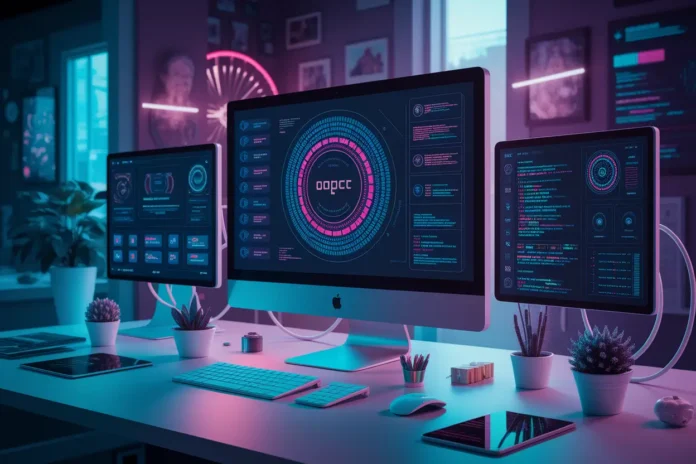Generative AI tools are transforming how businesses, creatives, and everyday users engage with technology by allowing machines to generate original content including text, images, audio, and even code. In 2025, the landscape of generative AI tools is more advanced and diverse than ever, offering solutions tailored for various domains such as communication, design, research, and development. In this guide, we explore the top generative AI tools in 2025, understand the core technologies behind them, compare their features, and analyze their real-world implications and future potential.
Top Generative AI Tools 2025: Revolutionizing Content Creation
The focus on generative AI tools has led to significant advancements across different industries. Here’s a breakdown of the leading platforms making waves in 2025.
ChatGPT-5 by OpenAI: Leader in Conversational Generative AI Tools
ChatGPT-5 is a cutting-edge tool that combines the power of multimodal inputs—text, voice, and images—for more natural and interactive conversations. It enhances logical reasoning and allows the creation of custom AI agents that cater to specific needs, such as customer service tasks, editorial assistance, and educational tutoring. ChatGPT-5 also supports document analysis, making it a versatile assistant for both professional and academic settings.
Google Gemini: Seamless Integration into the Workspace
Formerly known as Bard, Google Gemini has redefined productivity tools by embedding generative capabilities into core applications like Gmail, Docs, and Calendar. This integration bridges AI output with real-time data from Google Search. Users benefit from direct AI writing assistance, meeting summaries, and actionable suggestions across Android and iOS apps, turning Gemini into one of the most efficient generative AI tools for daily productivity.
MidJourney V5: Art and Design Empowered by Generative AI Tools
MidJourney V5 excels in digital art generation, enabling users to visualize ideas with remarkable detail. Its intuitive prompt system interprets user intent effectively, facilitating high-quality image output for uses like campaign visuals, book covers, and creative brainstorming. It’s specially valued in industries such as marketing, gaming, and film production where vibrant visual content is essential.

Perplexity AI: Smart Search-Backed Generative AI Tool
Perplexity AI combines AI-driven search functionalities with citation-based responses, making it a trusted source for researchers. Supporting models like GPT-4o and Claude 3.5 Sonnet, Perplexity generates comprehensive, factual answers while allowing file uploads and image queries. This tool exemplifies the promise of generative AI in academic and journalistic integrity preservation.
Mistral AI: Focused Generative AI Tools for Developers
Mistral AI, with models like Mistral Medium 3 and Devstral Small 24B, dominates the code-completion market. These tools empower developers to quickly debug and write code using open-source licenses. Mistral Medium 3 balances performance and cost, while Devstral Small 24B emphasizes flexibility in software development environments, making Mistral a favorite among programmers and startups.
Kittl: Typography-Centric Graphic Design with Generative AI
Kittl supports content creators with an extensive asset library including AI-generated images, backgrounds, and design templates. With a keen focus on typography and commercial-ready typefaces, it empowers users to create logos, posters, and social media content seamlessly. This tool reflects how generative AI tools are redefining the design space for professionals and amateurs alike.
ImagineArt by Vyro.ai: Multimedia Creation with Generative AI Tools
ImagineArt bridges the creativity gap by offering all-in-one solutions for image, music, video, and voice content. With mobile and desktop support, it democratizes access to generative media production. Users can compose AI music tracks, merge them with generated visuals, and edit full-scale video content from their devices.
Nexus AI by Verbosec: Enterprise-Oriented Generative AI Assistant
Nexus AI offers a multitool ecosystem powered by OpenAI models under Microsoft’s infrastructure. It provides tailored support in business writing, market research, and design. With integrated cloud collaboration, businesses adopt Nexus to streamline internal communications and content lifecycles using advanced generative AI tools.
Tencent’s Hunyuan3D-2.0: 3D Vision Through Generative AI Tools
Tencent’s innovations spotlight open-source 3D capabilities, enabling creatives to transform text and images into dynamic 3D assets within seconds. Ideal for gaming, education, and AR/VR development, Hunyuan3D-2.0 is crucial in illustrating Asia’s competitive advancements in the generative AI ecosystem.
Microsoft MAI-Image-1: Enterprise-Tier Image Generation
MAI-Image-1 is Microsoft’s entrée into in-house image synthesis. Delivering photorealistic results with lifelike textures and shadows, this tool integrates with Copilot and Bing Creator. Professionals in architecture, marketing, and media value this advancement for speedy mockups and production-ready visuals.
Key Concepts Powering Generative AI Tools
- Neural Networks: Models like transformers fuel the imagination of AI by identifying and mimicking deep data patterns.
- Training Data: Massive datasets act as the foundational memory for creative outputs.
- Fine-Tuning: Enables specialization in verticals like medicine, law, or language translation.
- Multimodal Interfaces: Modern generative AI tools now interpret audio-visual inputs along with text, creating truly interactive systems.
Advantages of Generative AI Tools in 2025
- Productivity Boost: Automates repetitive tasks like drafting, scheduling, and formatting.
- Creative Aid: Stimulates out-of-the-box thinking by offering rapid suggestions and iterations.
- Affordability: Many tools have freemium models, giving individuals access to advanced capabilities.
Limitations of Generative AI Tools to Consider
- Quality Risk: AI content can lack nuance or context and may require manual review.
- Unethical Uses: From misinformation to identity spoofing, the misuse risks are high.
- Inherent Bias: Datasets aren’t always diverse or neutral, leading to biased outputs.
Real-World Use Cases for Generative AI Tools
Generative AI tools are making practical impacts in areas like:
- Marketing: Automated ad copy and visuals save time and increase ROI.
- Education: Tutoring bots answer student queries, generate quizzes, and explain complex topics.
- E-commerce: Personalized product descriptions and customer chats reduce churn.
Industry Trends Shaping Generative AI Tools
Recent trends accelerating the evolution of generative AI include:
- Cross-Modal Integration: Tools like ChatGPT-5 and ImagineArt can process and generate image-audio combinations.
- Open-Source Acceleration: Firms like Mistral are pushing open models, giving power to developers.
- Enterprise Rollout: Microsoft and Google embedding generative AI directly into professional suites.
Choosing the Right Generative AI Tools
When deciding among the array of generative AI tools, ask:
- What type of content do you need: text, image, code, or multimedia?
- Does the tool support your workflow integrations?
- Is there an ongoing subscription cost or a free tier?
- Are security and licensing standards clearly established?
Tips for Integrating Generative AI Tools Effectively
- Start Small: Use AI for support-level tasks before scaling usage.
- Train Your Team: Help users understand tool capabilities and limitations.
- Monitor Outputs: Review all content for tone, accuracy, and relevance regularly.
Future Prospects for Generative AI Tools
In the coming years, generative AI tools will:
- Offer Customization: AI will use user data to fine-tune responses and outputs automatically.
- Require Less Power: Model advancements will reduce processing requirements.
- Be Regulated: New ethical standards will govern AI behavior, transparency, and creators’ responsibilities.
FAQs About Generative AI Tools
What are generative AI tools used for?
Generative AI tools are used to create original content like text, images, video, and audio with minimal human input. They streamline workflows in design, writing, education, and development.
Are generative AI tools accurate?
While highly sophisticated, generative AI outputs should be reviewed for accuracy, especially in sensitive domains like law or medicine.
Can I use generative AI tools without coding experience?
Yes, most modern tools have user-friendly interfaces designed for everyday users without technical expertise.
Is it safe to use generative AI tools for commercial projects?
Yes, provided the tool has appropriate licenses and content oversight mechanisms, it is safe for commercial use. Always read terms and usage policies.
How do generative AI tools work?
They use machine learning algorithms trained on large datasets to understand and replicate patterns found in human-created content, allowing them to produce new outputs.



